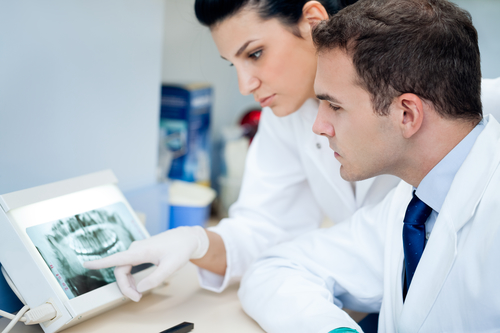
Due to a recent increase in oral cancer cases, your dentist may have begun performing oral cancer screenings at your routine exams. This simple screening catches problematic tissues as early as possible, and early detection makes successful treatment much more likely.
If you’re feeling a little nervous for what to expect during an oral cancer screening, read on to learn more about the process and what to watch for at home so you can prevent oral cancer from happening to you
Common Oral Cancer Symptoms To Watch For
Unfortunately, early home detection of cancerous tissues in the mouth may not be noticeable to the naked eye. If you’re experiencing any of the following, see your dentist immediately so they can perform a processional screening:
- Bumps, rough spots, eroded areas, or swelling on the lips, gums or inside the mouth
- White, red, or white speckled patches in the mouth
- Bleeding in the mouth
- Numbness or tenderness in the mouth, or on your face or neck
- Sores on the face, neck or mouth that bleed and are not healing
- Chronic sore throat or feeling like something is caught in your throat
- Difficulty chewing, swallowing, speaking or moving the tongue
- Hoarseness or change in vocalizations
- Earache
- Changing of your bite
- Extreme weight loss
What To Expect During An In-Office Screening
An oral cancer screening is a two part exam where your dentist will screen the oral cavity and connective tissues.
- Visual Exam – Using a light, mirror, and tongue depressor so they can see clearly, your dentist will perform a visual exam of the face, neck, lips inside your nose, and oral cavity. The dentist will be looking for asymmetries, swelling, bumps, patches of color, ulcerations or other abnormalities. This exam is much like your average physical you would receive at your doctors office.
- Physical Exam – After the visual exam, your dentist will then touch areas of the head, cheeks, around the jaw, under the chin and in the oral cavity to feel for unusual nodules or masses that are not visible with just the eye. Oral cancer symptoms can be painful, or in some cases completely painless.
Oral Cancer Risk Factors
Due to genetics, or related to lifestyle habits, some individuals are more likely to get oral cancer than others. Some of the risk factors include:
- Being A Male – Men have twice the risk of women to develop oral cancer, which may be related to men’s alcohol consumption and tobacco use
- Age – Those over the age of 50 have a higher risk of developing oral cancer, while the average age for diagnosis is 62.
- Tobacco Use – If you’re a smoker, you’re six times more likely to develop oral cancer than a non-smoker. If you use chewing tobacco, your odds of developing increase to 50 times more likely.
- Alcohol Consumption – If you drink, you are six times more likely to develop oral cancer than a non-drinker.
- Family History – Oral cancer can be genetic. If someone in your family has experienced oral cancer, you should receive frequent screenings
- Excessive Sun Exposure – The harmful rays of the sun cause damage to skin tissue
- HPV – Certain strains of Human papillomavirus are likely to cause oral cancer
ViziLite Screening for Oral Cancer
ViziLite TBlue is used to help oral healthcare professionals identify, evaluate, monitor and mark abnormal oral cell lesions suspicious for pathology including precancerous and cancerous cells that may be difficult to see during a regular visual exam.
ViziLite TBlue makes it easy to:
- Have a quick and easy system that incorporates seamlessly into a standard visual exam that only takes 2 minutes to complete
- Easily see and focus light inside the oral cavity because of its small size
- Have no false negative outcomes
- Significantly reduce the number of false positive lesions identified during standard visual exams
- Limit the number of biopsies that may have to be performed
If the ViziLite TBlue indicates potentially cancerous tissues, we will recommend a biopsy so that you can learn more. This early detections help save lives.
If you’re at a higher risk for oral cancer, we urge you to schedule your next screening today.
Related Articles
Congratulations on your new, fabulous Lumineers smile! However, once the procedure is done, many patients find themselves asking what they need to do next. This guide looks to answer all...
Invisalign is an amazing tool that can transform your smile with relative ease and without your treatment being noticeable. However, successful Invisalign treatment not only means sticking to your treatment...
Many people say they "hate the dentist." Don't worry, we know you don't hate us! You just hate the idea of lengthy, painful, stress-inducing dental treatments. Dental anxiety is probably...
